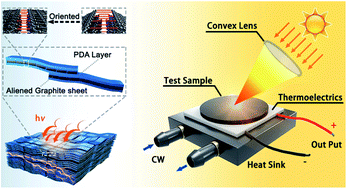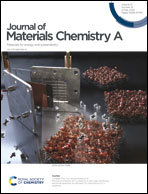A hierarchical thermal interface material based on a double self-assembly technique enables efficient output power via solar thermoelectric conversion†
Abstract
The solar thermoelectric generator (STEG) device, which provides electricity from solar irradiation power based on the Seebeck effect is a promising strategy for clean solar energy utilization. The integration of thermal interface materials (TIMs) and modified STEG enables efficient thermal conduction and conversion for sustainable energy output, further rendering the inverse application as the semiconductor cooler based on the Peltier effect. However, the limited output power density (<50 W m−2) results from the deficient thermal conductive property of TIMs still restricting the widespread application of STEG. Herein, a structured TIM with oriented percolating networks is fabricated through a double self-assembly technique, exhibiting a high in-plane thermal conductivity of 35.29 W m−1 K−1. These microstructure characteristics enable well-developed thermoconductive pathways with low thermal resistance, allowing concentrated thermal energy to be efficiently distributed through the TIM. In the robot-based thermal management test system, a nearly 13.5 °C decrease in the transmission chip is obtained from this TIM when compared to the commercial product. Furthermore, a distinguished output power density of 165.8 W m−2 is also achieved in the STEG device by real-environment solar-thermoelectric conversion, which is comparable to some commercial photovoltaic devices. This study not only exhibits potential prospects in advanced thermal management systems but also provides prospective alternatives for high electricity supply from solar energy.



 Please wait while we load your content...
Please wait while we load your content...